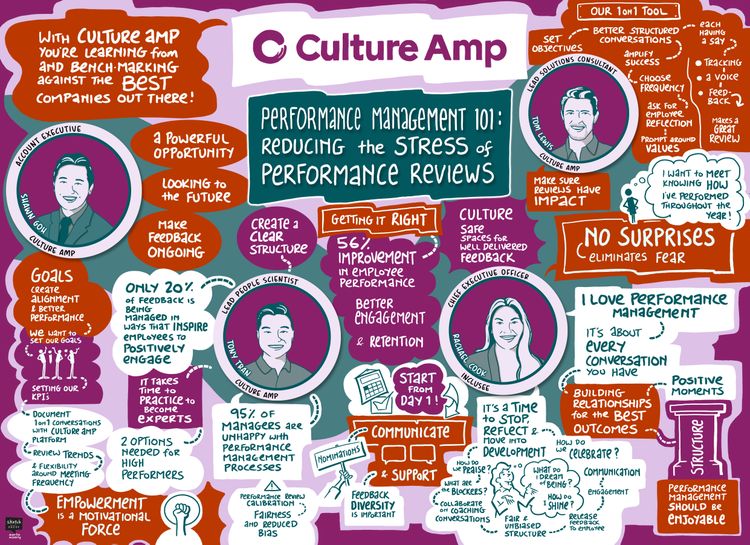
Performance management 101: How to transform your process

The success of your organization hinges on your people, so understandably, you want them to be at their best. Getting there requires some effort – not just from the employee, but also from their manager and the entire company.
That’s the crux of the performance management process. It’s a system leaders can use to set expectations, align visions, and develop employees.
Yet performance management – and more specifically, performance reviews – can trigger a lot of anxiety for everyone involved. To some employees, they may feel like a structured form of criticism rather than an opportunity for learning and support.
Organizations can change that perception. In the second session of our “Back to Basics” webinar series, Tony Tran, Lead People Scientist here at Culture Amp, and Rachael Cook, Chief Executive Officer at Inclusee, discussed how leaders can reduce the stress of performance reviews so everybody can use that look back to move forward.
What is performance management?
Performance management has negative connotations. People think of it as a process that’s only meant to address and manage poor performance, but there’s a positive side, too.
“At Culture Amp, we see performance management as much more than just a formalized process for measuring employees,” Tony says. “It’s actually a powerful opportunity to identify areas for development which can increase both organizational and individual performance and engagement over time.”
Performance management isn’t about a single step, process, or conversation. “Performance management, when done right, is about every conversation that you’re having with your employee,” Rachael explains. How are you celebrating, enlightening, supporting, and guiding your employees?
“If it’s done correctly,” Rachael adds, “It should be an enjoyable process for everybody involved.”
Why does performance management matter?
Performance management isn’t something you do once and check off your list – it requires constant commitment from managers and employees. This offers a number of advantages:
- Improved performance: Adequately managing performance gives employees a boost. Culture Amp research shows that employee productivity increases by as much as 56%.
- Promotions and pay: Performance management plays a huge role in decisions about advancement and compensation. A fair and thorough process reduces bias and increases fairness, which can ease employee fear or apprehension.
- Job satisfaction: Employees are 3.6x more engaged when they have a voice in setting their own goals and aligning them to the company initiatives.
Rachael adds that, while performance reviews are a solid opportunity to reflect on the things employees have achieved, they’re not exclusively focused on what’s already happened – they’re a chance to look forward, too.
“It’s an opportunity for us to start talking about what the future holds for our employees,” she says. “How do we as leaders actually help them get there?”

How to improve performance management (and reduce anxiety) in your own organization
Everybody stands to gain from solid performance management, yet organizations struggle to do it well. Culture Amp data shows that only 20% of employees strongly agree that their performance is managed in a way that actually motivates them to do outstanding work.
Managers aren’t happy either, with 95% of them saying they’re dissatisfied with the performance management process in their organization.
Tony and Rachael agree that it’s crucial to reduce the process's complexity and improve the managers' proficiency. This simplifies the performance management process and makes it less daunting for everyone involved. Here are five tips to make that happen.
1. Be clear about what employees should expect
Include information about performance management in your employee onboarding process. What does the performance process look like? When does it happen? That’s vital for people to know and prepare for as they get up to speed at your organization.
But even so, most people need a refresher on the process – even if they do it every six months or each year. For that reason, Rachael says there’s no substitute for clear communication.
“We’re making sure we’re communicating what happens at what stage, what to expect at each stage, and to ensure we’re giving enough time at each stage,” she says. At Inclusee, the performance management process is broken down into four separate stages – each with a clear date range attached.
“It’s really helpful to orient it to what you have each week and you can plan your work around it,” adds Tony. Leaders can also use that detailed timeline to better prepare their own teams.
“If we have that clear communication, it’s one of the components of how we can take that fear out of the performance management process for everybody,” Rachael says.
2. Choose the right words and scale
Your words matter, particularly when it comes to performance reviews. Using the right words will have a major impact on how employees respond during their reviews.
For example, rating scales that include the word “average” are very positively skewed. Nobody wants to tell somebody they’re average, so they opt for a better rating. In comparison, scales that refer to expectations (for example, “consistently meets expectations” instead of “average”) are much less positively skewed.
Additionally, Tony mentions that a four-point scale is typically the best choice for performance review questions. For example, the four choices could be:
- Needs development
- Consistently meets expectations
- Often exceeds expectations
- Set a new standard
“It removes that middle option which eliminates central tendency bias, which is the inclination to choose the middle option,” he explains. “Having two options for high performers also allows you to differentiate between different levels of performance.”
3. Create better goals
“Goals are important because they create alignment, they create clarity and focus, and they create employees that are more engaged and more motivated,” says Tony.
But this isn’t just about setting targets and passing them down to employees in the interest of performance monitoring. Goals are most effective when you:
- Encourage empowerment: Research shows that employees are more likely to achieve their goals if they can set them for themselves – or at least participate in the process.
- Use the right tools: Spreadsheets and Word documents are too clunky for managing goals and performance with clarity. Using a dedicated tool guides managers and employees through the process.
- Align them with a larger purpose: Employees need to understand the reasons behind why they do the work they do. Ladder up individual and departmental goals to organizational goals. That drives motivation, fuels a sense of belonging, and helps people focus their efforts.
4. Commit to regular 1-on-1 meetings
Part of what makes performance reviews so intimidating is that they feel uncertain. That’s why Rachael’s motto for performance management is “no surprises.” Eliminating surprises helps to eliminate the fear of the unknown. At Inclusee, that means:
- Building a culture of feedback
- Creating a safe space for people to share, receive, and learn from feedback
- Handling issues as they arise
Much of that comes back to regular 1-on-1 meetings between managers and direct reports. At Inclusee, every manager must have at least one 1-on-1 with every employee every week and maintain an open door policy.
“If we’re not having those right conversations and we’re getting to the performance review process, and we’re saving up all that feedback – whether it’s good or whether it’s constructive – and we’re dumping it on that employee there and then, of course, it’s not a good experience,” Rachael says.
“What we want to do with a performance review process is ensure that by the time we get to the actual review, we as leaders actually don’t need to do a lot,” she continues. “The process takes care of itself, and the employee should enter that review meeting knowing exactly what their performance is.”
5. Calibrate performance reviews
Performance reviews aren’t meant to be siloed activities. In fact, they’re most effective when there’s open dialogue about them.
“Performance review calibrations are a process in which managers discuss their proposed employee ratings with other managers,” explains Tony.
Doing so is meant to limit bias and increase employees’ perceptions of fairness in the entire process. Managers need to agree on set criteria that all direct reports are rated on, ensuring that employees who perform at similar levels receive similar ratings – no matter who they report to.
If a leader tends to rate people far too favorably or harshly, this process highlights that, allowing the leader to adjust their ratings. And a more fair process is a far less nerve-racking process.
Performance management: Less dread, more development
When your people improve, your organization improves – effective performance management is how to make that happen. Yet, it’s a process often fraught with trepidation and anxiety.
Fortunately, thorough planning and clear communication can keep the nerves at bay. That way, everybody can focus less on their hesitations and more on extracting as much value as possible from the process.





